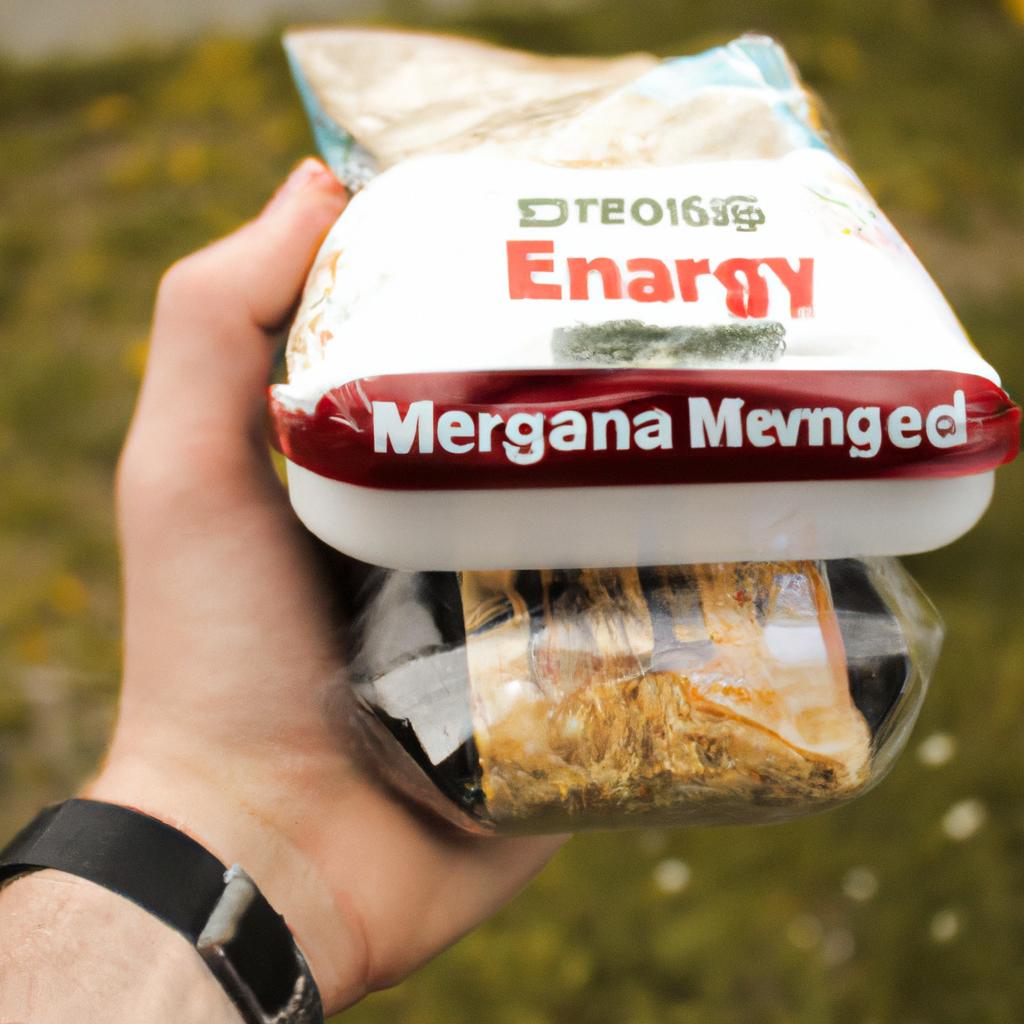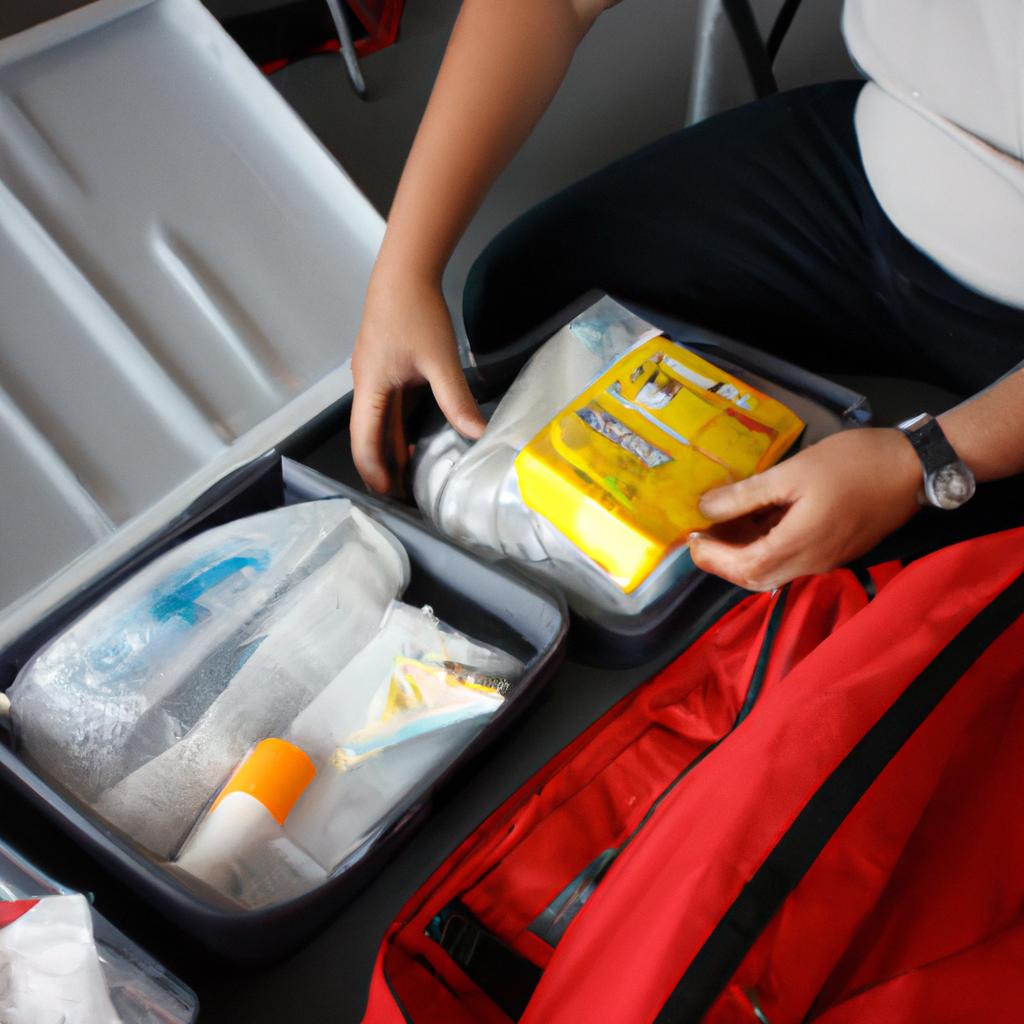In times of crisis or disaster, having a well-stocked emergency kit can be a matter of life and death. One essential component of an emergency kit is food that can sustain individuals and families for extended periods when access to fresh supplies may be limited. This comprehensive guide aims to provide valuable insights into the selection, preparation, and storage of emergency food items.
Consider the following scenario: A severe storm has hit a coastal town, leaving its residents stranded without electricity or access to grocery stores for several days. In this situation, having a reliable supply of non-perishable foods could mean the difference between hunger and sustenance. By understanding the key principles outlined in this guide, individuals will be equipped with the knowledge necessary to create an effective emergency food plan tailored to their specific needs and circumstances.
When it comes to assembling an emergency food kit, there are various factors one must consider – from nutritional value and shelf-life to dietary restrictions and personal preferences. By adhering to these guidelines, individuals can take proactive measures towards ensuring their own resilience during emergencies while also promoting community preparedness initiatives. It is our hope that through this comprehensive guide, readers will gain invaluable insights on how to make informed decisions regarding their emergency food preparations in order to safeguard themselves and their loved ones during times of crisis.
Types of emergency food
Types of Emergency Food
Imagine being caught in a natural disaster or other emergency situation, where access to food becomes limited or even nonexistent. Having an adequate supply of emergency food is crucial during such times, as it ensures you and your loved ones have nourishment until help arrives. In this section, we will explore the various types of emergency food available and their suitability for different situations.
There are several options when it comes to emergency food, each with its own unique advantages and considerations. First and foremost, canned goods are a popular choice due to their long shelf life and ease of storage. For example, a case study conducted by the National Disaster Preparedness Center found that individuals who had stocked up on canned foods were able to sustain themselves for extended periods during emergencies.
To further illustrate the range of choices available, let’s consider some key factors to keep in mind while selecting emergency food:
- Nutritional Value: It is essential to choose items that provide necessary nutrients like proteins, carbohydrates, vitamins, and minerals.
- Calories per serving: During emergencies, our bodies require extra energy to cope with stress and exertion. Opting for high-calorie foods can help meet these increased energy needs.
- Dietary Restrictions: If you or your family members have specific dietary restrictions (such as allergies or religious/ethical preferences), ensure that the chosen emergency food meets those requirements.
- Shelf Life: Look for products with extended shelf lives so that they remain safe for consumption over an extended period without spoilage.
Consideration should be given not only to the type of food but also how it is packaged. The table below provides a comparison between commonly used packaging methods:
| Packaging Method | Pros | Cons |
|---|---|---|
| Canned Foods | Long shelf life | Heavyweight |
| Freeze-dried | Lightweight | Requires water for rehydration |
| Meal pouches | Lightweight and compact | Limited variety of food options |
| Energy bars | Convenient and portable | May lack essential nutrients |
By understanding the different types of emergency food available, along with their pros and cons, you can make an informed decision when building your emergency kit.
[Transition] Now that we have examined the various types of emergency food, let’s delve into the factors that should guide your selection process.
Factors to consider when choosing emergency food
Having discussed the different types of emergency food available, let us now shift our attention to the factors that should be considered when choosing these essential provisions.
Factors to consider when choosing emergency food:
When selecting emergency food for your kit, it is crucial to keep several important considerations in mind. Let’s explore some key factors that can greatly impact your decision-making process:
-
Nutritional Value: The nutritional content of the emergency food you choose plays a vital role in sustaining energy levels during times of crisis. Opting for options rich in proteins, carbohydrates, and healthy fats will provide the necessary nutrients needed for survival. For example, imagine being trapped during a severe storm with only high-sugar snacks as your source of sustenance – they might initially boost your energy but could lead to an eventual crash.
-
Shelf Life: Another significant factor to take into account is the shelf life of the emergency food. Consider how long each item can remain edible without refrigeration or specific storage conditions. Having non-perishable items like canned goods or dehydrated meals allows for longer-term planning and reduces concerns about spoilage.
-
Dietary Restrictions: It is vital to acknowledge any dietary restrictions or allergies within your household while stocking up on emergency food supplies. Ensure that you have suitable alternatives available if anyone has specific dietary needs such as gluten-free, vegetarian/vegan, or nut-free options.
-
Storage Space: Assessing your storage capabilities is also critical before purchasing emergency food items. Depending on the size of your home or designated emergency area, you may need to prioritize compact and space-efficient choices over bulkier options.
To better visualize this information, refer to the following table highlighting these factors:
| Factors | Importance |
|---|---|
| Nutritional Value | High |
| Shelf Life | Medium |
| Dietary Restrictions | Medium |
| Storage Space | Low |
By considering these factors, you can make well-informed decisions when selecting emergency food for your kit. Next, we will explore non-perishable food options that are commonly recommended for long-term storage and emergency situations.
[Transition sentence to the next section about “Non-perishable food options”] As we delve into the realm of non-perishable food choices, let us now examine various alternatives that offer extended shelf life and nutritional value.
Non-perishable food options
Factors to Consider When Choosing Emergency Food
One example of the importance of choosing the right emergency food can be seen in a hypothetical scenario where a family is stranded in their home due to severe weather conditions. The power has been cut off, and they have no access to fresh groceries or cooking appliances. In this situation, having non-perishable food options becomes essential for their survival.
When selecting emergency food for your kit, there are several factors that should be taken into consideration:
-
Nutritional Value: It is crucial to choose food items that provide adequate nutrition during an emergency. Look for options that offer a balance of carbohydrates, proteins, and fats, as well as essential vitamins and minerals. This will help sustain energy levels and overall health during challenging times.
-
Shelf Life: Since emergencies can last anywhere from a few days to several weeks, it is important to select foods with a long shelf life. Opting for non-perishable items such as canned goods or dehydrated products ensures that your supplies will remain safe to consume even after extended periods.
-
Dietary Restrictions: Take into account any specific dietary requirements or restrictions within your household when choosing emergency food items. For individuals with allergies or certain medical conditions, it may be necessary to prioritize allergen-free or specialized products.
-
Ease of Preparation: During emergencies, resources like electricity or gas may not be readily available for cooking purposes. Therefore, consider foods that require minimal preparation and can be consumed without the need for extensive cooking equipment or heat sources.
To illustrate the significance of these considerations further, let’s take a look at the following bullet-point list:
- Longer shelf life means less worry about expiration dates.
- Adequate nutritional value contributes to physical stamina and mental well-being.
- Dietary restrictions must be accommodated so everyone stays healthy.
- Easy-to-prepare meals save time and effort when resources are limited.
Additionally, here is a table highlighting some common non-perishable food options and their corresponding benefits:
| Food Item | Shelf Life | Nutritional Value | Dietary Restrictions |
|---|---|---|---|
| Canned beans | Up to 5 years | High in protein | Gluten-free |
| Peanut butter | Up to 2 years | Good source of fat | Allergen warning: peanuts |
| Oatmeal packets | Up to 1 year | Source of fiber | Vegan-friendly |
| Dried fruits | Up to 12 months | Vitamins and minerals | Diabetic-friendly |
In conclusion, choosing the right emergency food involves considering factors such as nutritional value, shelf life, dietary restrictions, and ease of preparation. By carefully selecting non-perishable items that meet these criteria, you can ensure that your emergency kit is well-equipped for any unforeseen circumstances.
Dehydrated and freeze-dried food
Transitioning from the previous section on non-perishable food options, let us now explore another category of emergency food that is highly popular among preppers: dehydrated and freeze-dried food. These types of foods have gained significant attention due to their long shelf life, lightweight nature, and convenience in terms of preparation.
To illustrate the effectiveness of dehydrated and freeze-dried food during emergencies, consider this hypothetical scenario: a family finds themselves stranded in their home for several days following a severe winter storm. With limited access to fresh groceries or cooking facilities, they rely on their emergency food supply. This includes a variety of dehydrated meals such as pasta dishes, rice-based entrees, and even desserts like apple cinnamon oatmeal. By simply adding hot water to these pouches, they are able to enjoy nourishing and tasty meals amidst the challenging circumstances.
When considering dehydrated and freeze-dried food for your emergency kit, here are some key points to keep in mind:
- Long Shelf Life: Dehydrated and freeze-dried foods often have extended shelf lives ranging from 5 to 25 years, making them ideal for long-term storage.
- Nutritional Value: Despite being processed foods, many manufacturers strive to retain the nutritional value of ingredients through careful dehydration techniques. Look for brands that prioritize preserving essential vitamins and minerals.
- Lightweight Packaging: One advantage of dehydrated and freeze-dried food is its compact packaging. These products are typically stored in lightweight pouches or cans that won’t weigh you down during evacuation scenarios.
- Versatile Options: From breakfasts to main courses and snacks, there is a wide range of dehydrated and freeze-dried food available today. Consider your dietary preferences and any potential allergies when selecting items for your emergency kit.
To further assist you in evaluating different options within this category, we present below a comparison table showcasing four popular brands of dehydrated and freeze-dried food:
| Brand | Shelf Life | Nutritional Value | Variety of Meals |
|---|---|---|---|
| Brand A | 10 years | Balanced | Extensive |
| Brand B | 15 years | High protein | Limited |
| Brand C | 25 years | Allergen-free options | Moderate |
| Brand D | 5 years | Organic | Vegetarian |
As you can see, each brand offers unique features that may align with your specific needs and preferences. It is advisable to conduct further research and read customer reviews before making a final decision.
Transitioning into the subsequent section about canned food and ready-to-eat meals, it becomes evident that emergency food choices are vast and varied. By exploring these different categories, you will be better equipped to create an effective emergency kit tailored to your requirements.
Canned food and ready-to-eat meals
Moving on from dehydrated and freeze-dried food options, let’s explore another essential component of your emergency kit – canned food and ready-to-eat meals. These items provide convenience and sustenance during emergencies when cooking facilities may be limited or non-existent.
To illustrate the importance of these options, consider the following hypothetical scenario: Imagine being stranded in a remote area due to a natural disaster, such as a hurricane or earthquake. You have no access to fresh food or clean water for several days. In this situation, having canned food and ready-to-eat meals would ensure you have nourishment until help arrives.
When considering which canned foods to include in your emergency kit, keep in mind their long shelf life and nutritional value. Here are some key characteristics to look for:
- Nutrient-rich content that provides essential vitamins and minerals
- Durable packaging that can withstand harsh conditions
- Easy-open lids or pull tabs for accessibility without tools
- Variety of options to cater to different dietary needs (e.g., vegetarian, gluten-free)
Table: Comparing Different Types of Canned Foods
| Type of Canned Food | Benefits | Examples |
|---|---|---|
| Soups | Provide warmth and hydration | Chicken noodle soup |
| Fruits | Offer natural sugars for energy | Pineapple slices |
| Vegetables | Supply essential nutrients | Green beans |
| Proteins (meats) | Serve as a source of protein | Tuna |
- The convenience of ready-to-eat meals cannot be overstated during an emergency.
- They require no preparation or heating, making them ideal when resources are scarce.
- Ready-to-eat meals often come with utensils included, eliminating the need for extra supplies.
- Their compact packaging allows for easy storage and transportation.
Including a variety of canned food options in your emergency kit ensures you have a well-rounded supply during times of crisis. Additionally, ready-to-eat meals offer the advantage of being self-contained with all necessary components included. By carefully selecting these items based on their nutritional value, durability, and ease of access, you can be better prepared to sustain yourself until help arrives.
Now that we have covered the importance of canned food and ready-to-eat meals, let’s move on to discussing long-term food storage tips to ensure the longevity and safety of your emergency food supplies.
Long-term food storage tips
Transitioning from the previous section on canned food and ready-to-eat meals, we now turn our attention to long-term food storage tips. Ensuring that your emergency kit contains properly stored food is crucial for maintaining its quality and nutritional value over extended periods of time. In this section, we will explore key strategies and considerations for storing food in preparation for emergencies.
To illustrate the importance of long-term food storage, let us consider a hypothetical scenario where a severe storm causes widespread power outages for several weeks. Without access to grocery stores or fresh produce, having an adequate supply of stored food becomes essential. By following these guidelines for long-term food storage, you can better prepare yourself and your loved ones for unexpected situations.
Firstly, it is vital to choose foods with longer shelf lives that require minimal refrigeration. Some examples include dried fruits, nuts, jerky, powdered milk, rice, beans, pasta, and dehydrated soups. These items are not only lightweight but also offer substantial nutritional value when preserved correctly.
When storing such foods, here are some important considerations:
- Keep the containers tightly sealed: To prevent moisture and air exposure that could lead to spoilage or contamination.
- Store in a cool and dark place: Excessive heat can cause deterioration in taste and quality.
- Rotate your stock regularly: Use older products first while replenishing them with newer ones.
- Label everything clearly: Include the purchase date or expiration date on each item to ensure proper rotation.
In addition to these guidelines, establishing an organized system can significantly contribute to efficient management of your stored food supplies during emergencies. Consider utilizing a three-column table like the one below as part of your organization strategy:
| Food Item | Quantity | Purchase Date |
|---|---|---|
| Rice | 10 lbs | 01/2022 |
| Dried Fruits | 5 packs | 03/2023 |
| Nuts | 3 lbs | 09/2022 |
| Pasta | 8 packs | 06/2024 |
By maintaining a comprehensive list and regularly updating it, you can easily keep track of your inventory and ensure that your emergency food supply remains well-stocked and properly rotated.
In summary, long-term food storage is a critical aspect of emergency preparedness. By selecting the right foods with longer shelf lives and implementing proper storage techniques, you can be better equipped to handle unexpected situations in which access to fresh produce or grocery stores may be limited. Furthermore, employing an organized system for managing your stored food supplies will help ensure their longevity and availability when needed most.




